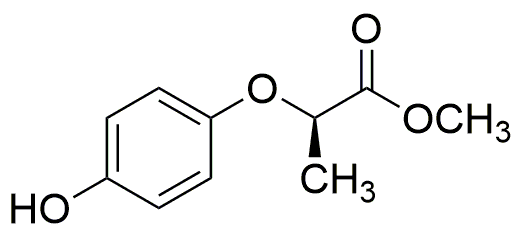Methyl (R)-(+)-2-(4-hydroxyphenoxy)propionate is widely utilized in research focused on:
- Pharmaceutical Development: This compound serves as an important intermediate in the synthesis of various pharmaceuticals, particularly those targeting hormonal and anti-inflammatory pathways.
- Agricultural Chemicals: It is used in the formulation of agrochemicals, enhancing the efficacy of herbicides and pesticides by improving their absorption and activity in plants.
- Cosmetic Formulations: The compound acts as a skin-conditioning agent in cosmetics, providing moisturizing properties and improving the texture of skincare products.
- Research in Biochemistry: It is utilized in studies exploring enzyme interactions and metabolic pathways, helping researchers understand complex biological processes.
- Polymer Chemistry: This chemical can be incorporated into polymer matrices to enhance material properties, such as flexibility and resistance to degradation, making it valuable in materials science.
General Information
Properties
Safety and Regulations
Applications
Methyl (R)-(+)-2-(4-hydroxyphenoxy)propionate is widely utilized in research focused on:
- Pharmaceutical Development: This compound serves as an important intermediate in the synthesis of various pharmaceuticals, particularly those targeting hormonal and anti-inflammatory pathways.
- Agricultural Chemicals: It is used in the formulation of agrochemicals, enhancing the efficacy of herbicides and pesticides by improving their absorption and activity in plants.
- Cosmetic Formulations: The compound acts as a skin-conditioning agent in cosmetics, providing moisturizing properties and improving the texture of skincare products.
- Research in Biochemistry: It is utilized in studies exploring enzyme interactions and metabolic pathways, helping researchers understand complex biological processes.
- Polymer Chemistry: This chemical can be incorporated into polymer matrices to enhance material properties, such as flexibility and resistance to degradation, making it valuable in materials science.
Documents
Safety Data Sheets (SDS)
The SDS provides comprehensive safety information on handling, storage, and disposal of the product.
Product Specification (PS)
The PS provides a comprehensive breakdown of the product’s properties, including chemical composition, physical state, purity, and storage requirements. It also details acceptable quality ranges and the product's intended applications.
Certificates of Analysis (COA)
Search for Certificates of Analysis (COA) by entering the products Lot Number. Lot and Batch Numbers can be found on a product’s label following the words ‘Lot’ or ‘Batch’.
*Catalog Number
*Lot Number
Certificates Of Origin (COO)
This COO confirms the country where the product was manufactured, and also details the materials and components used in it and whether it is derived from natural, synthetic, or other specific sources. This certificate may be required for customs, trade, and regulatory compliance.
*Catalog Number
*Lot Number
Safety Data Sheets (SDS)
The SDS provides comprehensive safety information on handling, storage, and disposal of the product.
DownloadProduct Specification (PS)
The PS provides a comprehensive breakdown of the product’s properties, including chemical composition, physical state, purity, and storage requirements. It also details acceptable quality ranges and the product's intended applications.
DownloadCertificates of Analysis (COA)
Search for Certificates of Analysis (COA) by entering the products Lot Number. Lot and Batch Numbers can be found on a product’s label following the words ‘Lot’ or ‘Batch’.
*Catalog Number
*Lot Number
Certificates Of Origin (COO)
This COO confirms the country where the product was manufactured, and also details the materials and components used in it and whether it is derived from natural, synthetic, or other specific sources. This certificate may be required for customs, trade, and regulatory compliance.


